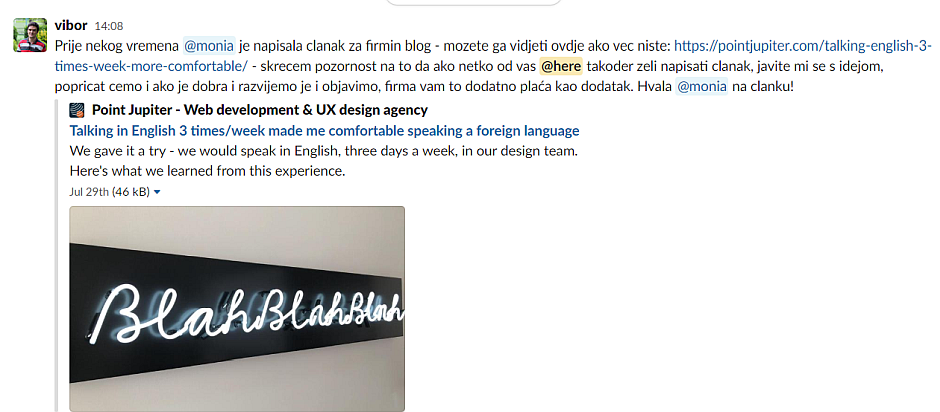What is an all-hands meeting and how to run one?
What is an all-hands meeting and how to run one? Learn from our experiences, tips, sample agenda, and ideas for your all-hands meeting.

I get it – nobody enjoys spending countless hours in meetings. But there are two crucial meetings for your growth – and it doesn’t matter if you are a (representative of) organization, employee, or a leader. They are 1-on-1 meetings and all-hands-meetings.
We shared our tips and ideas about 1-on-1 meetings and how to run them. In this article, I wanted to share a somewhat new practice that we are building here at Point Jupiter – running our all-hand meetings.
Sometimes, these meetings are also called all hands on deck, town hall meetings, or forum meetings. Regardless of their name, they (should) serve the same purpose: bringing the entire company (or an organization) together, share updates, ask and answer questions, and achieve general mission/vision alignment.
At least, that is how we should run all-hands meetings. In reality, however, management/the board often uses all-hands meetings to broadcast their messages to employees. That defeats the purpose. The idea here is not to run a radio station where you recite some of your messages.
What AHMs are about is meaningful dialogue, including all team members (hence the name) and giving them a chance to voice their own opinions, ask questions, and share their work. Make sure they are and that they feel included. Don’t forget about the remote workers and remote teams.
The larger your company grows, the larger is the perceived distance between employees and management and executives. But even if you are a smaller company, the challenges can be very similar. Especially now due to the COVID-19 pandemic and increased number of people working from home. We also shared some of our experiences working remotely during the COVID-19 pandemic.
Why run all-hands meetings?
AHMs are somewhat new to us here at Point Jupiter. As a CEO, I was looking for meaningful ways to connect all our teams and teammates.
On a very high level, we have two largest teams – designers (UX, UI, usability, accessibility, user research…) and developers (backend, frontend, DevOps, network…). In addition to them, we have the role of project manager and office manager/quality assurance, which don’t belong to a single team. Instead, their roles intertwine with both larger teams.
During my 1-on-1 meetings with all employees, one of the general topics was improving our mutual communication and understanding what other people are working on.
In cases where we have both designers and developers working on the same projects – that problem is not as pronounced. After all, they share resources, calls, meetings, and more.
But sometimes, we have design-only or development-only projects. And even if we have a project where developers and designers are working simultaneously, rarely are all the people we have working on that project. So, unintentionally, some information is omitted, and people sometimes only hear short bits and pieces of projects.
In addition to this, I wanted to figure out a better way to present our company-wide updates. Where are we right now, and where are we headed? What are the opportunities in front of us? Typically, I would use our Slack channel, pretentiously called #ceo-communiqué, to share some of those bits of information.
And that works great for shorter and, in most cases, non-critical information. For example, I would share info about the new blog post someone from our team wrote or congratulate national holidays – you get the point.

However, when we have something more substantial and significant, we relied on email or ad-hoc meetings. And that works reasonably well. But, as we advance, I wanted to find a meaningful, reliable, and sustainable way that would enable us to tackle the challenges of communication, shared vision, strategic updates, and more.
Enter all-hands meetings
How to run an all-hands meeting?
We divided this entire process into their chronological and organizational units. What do we do before the AHM, what happens during the AHM, and, lastly, what happens after the AHM?
Before the all-hands meeting
Think about what you are looking to achieve from the all-hands meeting you are organizing. Jot down the plan and think about what you need to run it. Think of it as a simple meeting agenda for a company-wide gathering.
Location
Is it on-site or combined, or completely remote? Running them all on-site is logistically easier as you can gather all the people in one room. However, depending on the country you are located in and current legislation, you might need to ensure proper epidemiological and hygienical measures to protect all attendees’ health and well-being. Social distancing, face-masks, and hand-sanitizers are some of the things that come up to my mind.
If you are running your AHM and some people are on-site, and some are working from their homes or elsewhere, you need to ensure that the video conferencing setup works as it should. Take 15 minutes before the AHM start to start your Meet, Zoom, Skype, and check that you can hear and see others. Be sure to place the cams in a way that people can see each other at all times.
Lastly, if you are all remote – make sure that you are on a reliable internet connection, that your cam and mic are working correctly and that you can hear and see everyone else.
Agenda and schedule
But, in any case, having an agenda, a plan if you will, for that day, is a must. It is a good idea to share it with your team several days in advance.
During the all-hands meeting
Keep in mind that people don’t like long and tedious meetings. Our attention span is short, and in the era of social media and constant notifications, it is even more challenging to stay focused.
We aim for our AHMs to last around 1 hour and 15 minutes. But we divided them into the following sections:
00:00 – 00:05 – Brief intro, last-minute adjustments, settling down.
00:05 – 00:20 – Let your CEO speak for 15 minutes. Not longer than that. Trust me; I can talk for hours. Most CEOs can – rarely a good idea.
It is good to force yourself to run within 15 minutes time slots. Share the company’s current position, your vision, and outlook for the future.
Be honest and forthcoming about possible challenges ahead of you, celebrate successes, lessons you learned, and motivate your team about the opportunities ahead. Don’t shy away from difficult topics. It’s the moments like those that give you the chance to be a leader, serve your team, and build trust.
00:20 – 00:35 – Call a representative from your team. I call the CTO from the development team (Design lead from the design team) to share what they have been working on in the past period.
I want us to hear what they are most proud of, what they are looking to improve, and what is ahead of them. Showcase projects, interesting situations – let us experience what you experienced and inform us all. This typically lasts for 15 minutes per team.
Feel free to mix things up. If the first team presenting were developers during October, make sure that you have designers start first during November.
00:35 – 00:50 The second 15-min slot is for another team.
00:50 – 01:10 – Leave the longest part of your AHM for questions and answers. Q&A sessions are an important part of AHMs and contribute to your company culture. If you are a smaller organization like we are here at Point Jupiter, people can ask questions right away.
For larger teams, it makes sense to submit questions before the AHM and then vote and select the ones that will get answered. This is the moment where employees can ask your CEO/leadership team anything. Please, encourage them to do so.
As I said at the beginning of this article – you are not a radio station broadcasting in one direction. The good practice is to repeat the question you were just asked. That makes sure that people who might be joining the AHM remotely can hear the question well, and it also ensures that you understood the question correctly.
Be polite but don’t sugarcoat the answers to challenging questions. You don’t want to cause panic – you want to present confidence, and you need to be confident. Those people expect answers; you are here to serve them and the company, not the other way around. Regardless if you have great things to share or you need to announce some painful and challenging measures.
Make sure that people can also ask each other questions – while most of them might have questions for the company leadership; they might also have questions for their peers. Give them enough time to ask those questions and get answers to them. After all, it’s the all-hands meetings, not just-some-hands meeting, and broad participation should be encouraged.
01:10 – 01:15 – Time to wrap up things. Thank everyone for attending and especially those who contributed by asking questions and being constructive.
After the all-hands meeting
It makes sense to send a brief-follow up to all attendees. Again, thank them for their time and contributions. List out some of the main points you discussed during your all-hands meeting, and make sure to say that you will be running another AHM in the future (depending on your organization, it might be every month, once per quarter… you know your company the best). And be sure to follow up on that!
As we advance with all-hands meetings…
We are somewhat new to this game. But we will run these AHMs in the future, and I hope that I will be able to update this post and share some more valuable insights, lessons learned, and experiences.
I hope this post shed some light on what all-hands meetings are and how to run all-hands meetings. I wish you a lot of good luck with yours!
Let’s connect
If you are looking to join our great team, head on to our Careers page, and apply. We will help you grow your development and engineering skills as well as your soft skills.
If you are a potential client, interested in hiring us, we should talk! We’d love to hear from you and learn how we can contribute to your success. Check out our work and cases and learn more about services Point Jupiter offers.